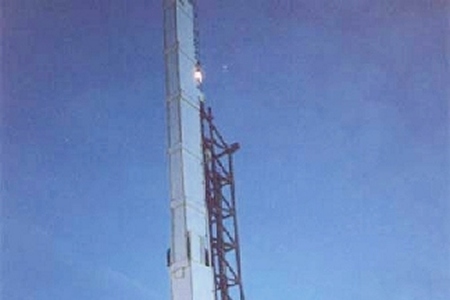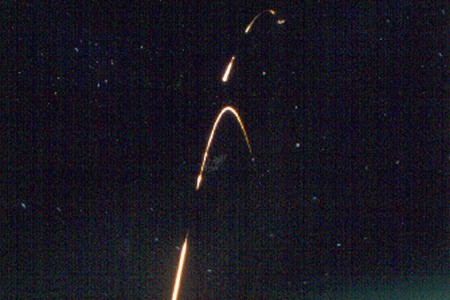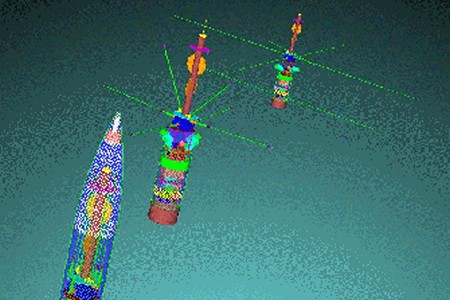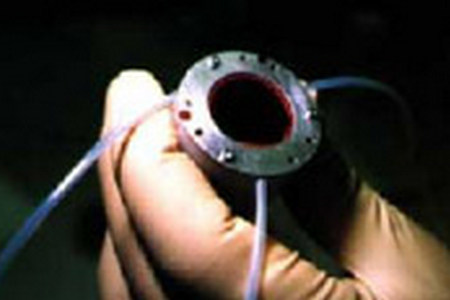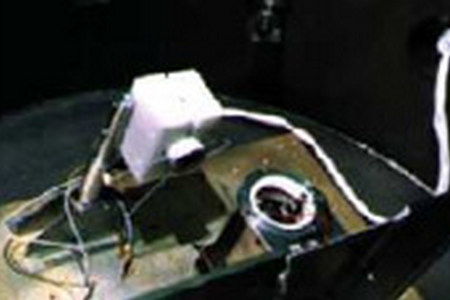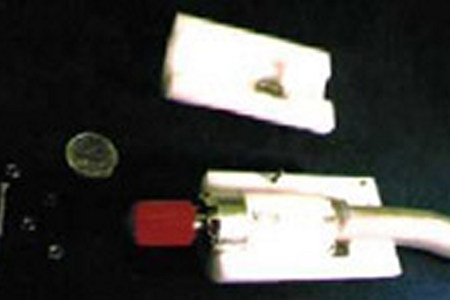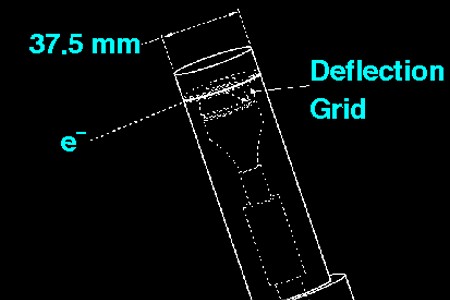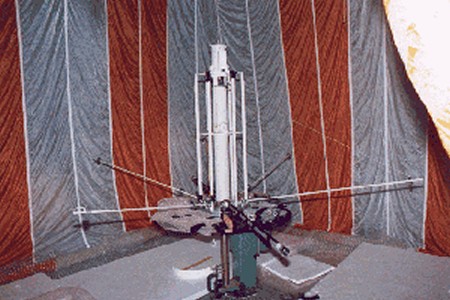GEODESIC Sounding Rocket
Launched successfully February 26, 2000 @ 09:19:10.3UT
The GEODESIC Sounding Rocket (Geoelectrodynamics and Electro-Optical Detection of Electron and Suprathermal Ion Currents) was designed to explore the fine structure of charged particle acceleration and wave-particle interactions in the topside auroral ionosphere. The mission emphasized high-time-resolution measurements of core electrons and ions, covering 0-10 eV and 0-50 eV respectively, and pitch angle-energy images every 10 ms, or 10 m along the rocket trajectory.
The high degree of spatial/temporal resolution was motivated by the increasingly apparent fact that auroral energy dissipation -- including localized ion heating, wave generation, and acceleration of auroral electrons -- is concentrated on scales of the order of, or less than, 100m. GEODESIC explored the pathways through which electromagnetic fields and accelerated particle populations couple energy into thermal populations, and through which the thermals in turn affect waves. A secondary objective of GEODESIC was to demonstrate the feasibility and utility of electro-optical detection of charged particles in space. This technique was motivated by the desire to improve measurement resolution in time, energy, and pitch angle.
To accomplish these objectives GEODESIC carried a complement of six instruments, two of which were newly developed at the U of Calgary specifically for the mission: 1) a thermal electron imager (TEI) measuring core electrons in the 0-10 eV range and 2) a suprathermal ion imager (SII) to measure core ions and suprathermal tails up to 50 eV. These two instruments were based on the Freja Cold Plasma Analyzer design but were miniaturized to reduce gyroradius distortion, particularly in the case of the TEI; they also exploited a new CCD-based detection scheme which allowed faster event rates and more uniform imaging than conventional charge-amplifier network schemes. These instruments had the advantage that they image in both angle and energy and thus are not susceptible to sample aliasing inherent in stepped-energy detection schemes. The GEODESIC TEI failed due to a premature deployment. The SII functioned successfully.
The movie above (Event 2) short bursts of ion heating to 100,000 K as GEODESIC flew through 20-m-wide, wave-filled, density-depleted cavities. The heating is seen as transient (5 frames = 55 ms) "wings" appear briefly the the left and right, corresponding to the plane perpendicular to the geomagnetic field B. See Knudsen et al. [2004].
The movie above (Event 4) shows SII image sequences as a substorm surge swept over the payload, accompanied by a large Alfven wave that wildly displaces the low-energy ion distribution by virtue of the large ion drifts within the 3-Hz wave. See Burchill et al. [2004] for more information.
In these images, energy goes from 0 to 20 eV (center to outside), and the geomagnetic field is approximately downward in the image
In addition to the core plasma sensors, other instruments included energetic electron and ion top-hat analyzers supplied by the Aerospace Corporation, a 3-axis electric field double-probe experiment supplied by NASA GSFC, and fluxgate and searchcoil magnetometers supplied by Magnametrics of Ottawa, Ontario.
GEODESIC was launched on a Black Brant 12 rocket from Poker Flat Rocket Range near Fairbanks, Alaska, to am apogee of 991 km. Funding for the development, construction and launch of the GEODESIC mission was provided by the Canadian Space Agency (CSA).
GEODESIC flew into an auroral expansion which reached along the entire trajectory. The aurora was intense near to, and surrounding, apogee (10 kR as seen through thick haze above Kaktovic). The Kaktovic, Alaska magnetometer showed a 750 nT bay, with intense higher-frequency fluctuations seen on ground-based searchcoils.
GEODESIC Science Team
| Personnel | Institution |
|---|---|
| David J. Knudsen (Mission Scientist) (PI: Suprathermal Ion Imager / Thermal Electron Imager) | University of Calgary, Calgary, AB |
| Scott Bounds | NASA Goddard Space Flight Center, Greenbelt, MD |
| James H. Clemmons (PI: Energetic Particle Experiment) | The Aerospace Corporation, Los Angeles, CA |
| Fokke Creutzberg (CANOPUS Support) | Keometrics, Ottawa, ON |
| Marc Lessard and James LaBelle | Dartmouth College, Hanover, NH |
| Robert F. Pfaff (PI: Electric Field Instrument) | NASA Goddard Space Flight Center, Greenbelt, MD |
| George J. Sofko (SuperDARN Support) | University of Saskatchewan, Saskatoon, SK |
| Donald D. Wallis (PI: Magnetic Field Instrument) | Magnametrics, Ottawa, ON |
| Eric Donovan | University of Calgary, Calgary, AB |
| Trond S. Trondsen | University of Calgary, Calgary, AB |
| Andrew W. Yau | University of Calgary, Calgary, AB |
| Industrial Partner: | Bristol Aerospace Limited, Winnipeg, MB |
SII/TEI Development Team (UofC)
Peter Smith
Tim Cameron
Greg Enno
Kaare Berg
Johnathan Burchill
Ivan Weavers
Andrew Yau
David Knudsen
Peter King
Cliff Marcellus
Publications
Knudsen, D.J., Kabirzadeh, R., Burchill, J.K., Pfaff, R.F., Wallis, D.D., Bounds, S.R., Clemmons, J.H. and Pinçon, J.L., 2012. Strong magnetic field fluctuations within filamentary auroral density cavities interpreted as VLF saucer sources. Journal of Geophysical Research: Space Physics, 117(A2).
Burchill, J.K ., High-resolution Observations of Core and Suprathermal Ions in the Auroral Ionosphere: Techniques and Results from the GEODESIC Sounding Rocket, PhD thesis, University of Calgary, September 2003. Received the 2004 Innovation in Technology Award, Western Association of Graduate Schools ( U.S. and Canada ) and the American Geophysical Union's 2005 Fred L. Scarf award for the best Ph.D. dissertation in Space Physics and Aeronomy
Bock, B.J.J ., Study of Lower-Hybrid Cavities Detected by the GEODESIC and OEDIPUS-C Sounding Rockets, MSc Thesis, University of Calgary, March 2005.
Knudsen, D. J., B. J. J. Bock, S. R. Bounds, J. K. Burchill, J. H. Clemmons, J. D. Curtis, A. I. Eriksson, M. E. Koepke, R. F. Pfaff, D. D. Wallis, and N. Whaley, Lower-hybrid cavity density depletions as a result of transverse ion acceleration localized on the gyroradius scale, J. Geophys. Res., 109, A04212, doi:10.1029/2003JA010089, 2004.
Burchill, J. K., D. J. Knudsen, B. J. J. Bock, R. F. Pfaff Jr., D. D. Wallis, J. H. Clemmons, S. R. Bounds, and H. Stenbaek-Nielsen, Core ion interactions with BB ELF, lower hybrid, and Alfvén waves in the high-latitude topside ionosphere, J. Geophys. Res., 109, A01219, doi:10.1029/2003JA010073, 2004.
Knudsen, D. J., J. K. Burchill, K. Berg, T. Cameron, G.A. Enno, E.P. King, C.G. Marcellus, I. Wevers, and R.A. King, A low-energy charged particle distribution imager with a compact sensor for space applications, Rev. Sci. Inst., 74, 202, 2003.

